MEASURING UP



EDITORS-IN-CHIEF
Alex Osburn
Ajay Singireddy
Jasmine Yang
IN-DEPTH TEAM
Izzy Munn
Sylvia Sasse
Deshna Venkatachalam
Lydia Weed
PHOTO EDITORS
Novah Ulm
Grace Wheatley
ART DIRECTOR
Sylvia Sasse
SOCIAL MEDIA TEAM
Chloe LaVelle
Brynn Stewart
Deshna Venkatachalam
STAFF
Jocelyn Aguilar
Sarynel Barbosa
Nicolas Bowers
Aidan Brown
Liz Carrigan
Gabe Carrillo
Claire Davis
Stella Gaylord
Annie Green
Jaedyn Greenlee
Lois Guest
Cecilia Gutierrez
Maia Jamieson
Emma Warnock
ADVISERS
Roth Lovins
Rachel McCarver

Looking
into a high schooler’s perspective on eating disorders and body image

Scan with your iPhone camera (Snapchat, too) to be linked to all of CNHS Media's socials.
The Triangle is the designated forum for student expression at Columbus North High School. The student staff chooses all content.
Signed columns published in The Triangle express the writer’s personal opinion and not the views of The Triangle, student body, BCSC, administration, board of trustees or faculty of Columbus North.
The Triangle practices ethical journalism by providing balanced and fair coverage as determined by community standards. The Triangle strives to achieve 100 percent accuracy by checking sources, spelling, and quotes and attaining multiple sources.
The Triangle encourages letters to the editor, but reserves the right to reject them for reasons including but not limited to lack of space, multiple letters of the same topic and personal attacks contained in the letter. The Triangle will not edit for content, but reserves the right to edit for grammar and length. Letters should be submitted to room 1507 or sent via e-mail to administrator@ cnhsmedia.com. All Letters much be signed by all persons involved in writing the letter, which the staff will check for validation. A letter sent via e-mail must be validated with a signature from the writer before The Triangle will publish it. If responding to a publication, letters must be turned in within one week of that
publication’s distribution.
In the event of death, The Triangle will run a standard obituary. Pertaining to work submitted via social media sites (Facebook, Twitter, etc.), The Triangle will only accept written submissions from the original poster and owner and will only publish entries with the permission of the original poster and owner. The Triangle will not edit submissions for content and reserves the right not to publish them for reasons including but not limited to lack of space, multiple submissions of the same topic, vulgar or incendiary content. The Triangle will not publish photographs from Facebook. Posts on The Triangle’s social media pages by readers are owned by the readers and do not necessarily express the views or opinions of the staff. The Triangle is not responsible for their content and reserves the right to delete and report any inappropriate and unnecessary posts. By posting on The Triangle’s social media pages, the poster grants The Triangle permission to publish the contents of that post. In cases when a source’s information may bring ridicule or incrimination upon himself or herself, the editorial board reserves the right to cite the source as anonymous. The Triangle will never use composite sources and pass them off as anonymous sources.
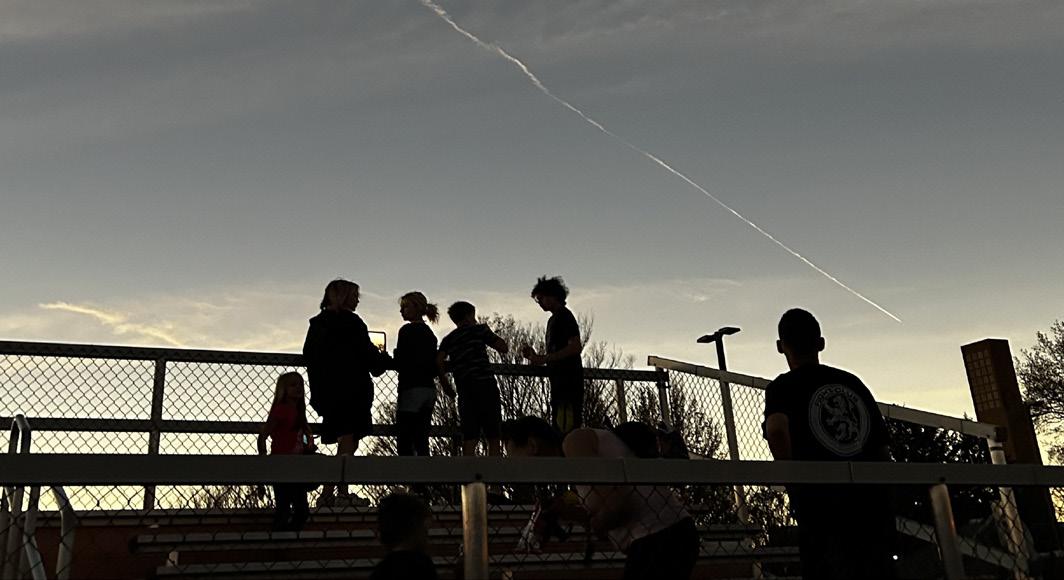

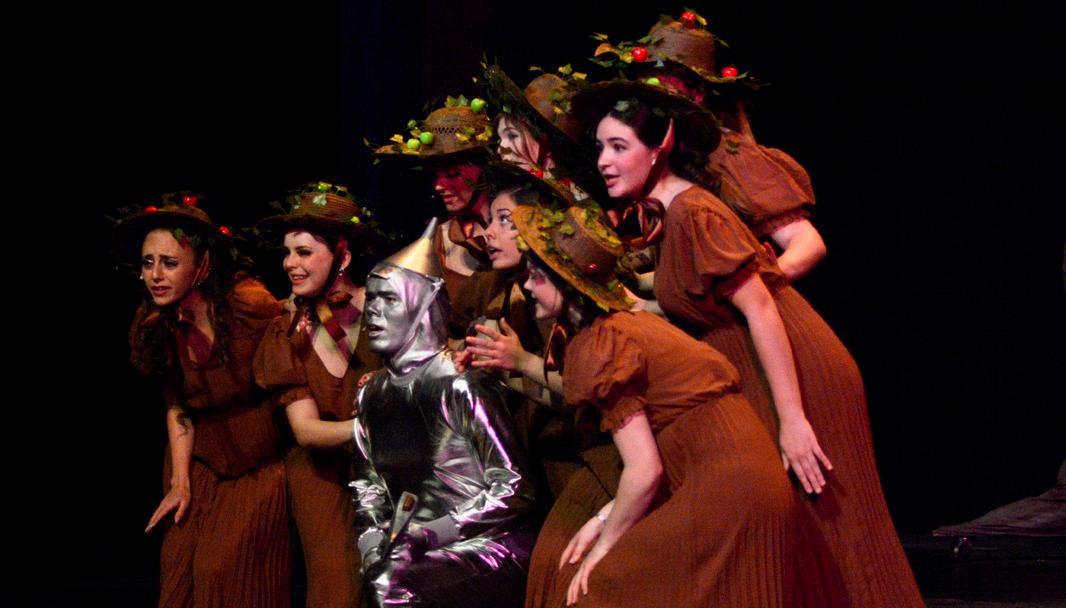

What the solar eclipse is and how students experienced itby Jasmine Yang design by Emma Warnock
As students observed the schedule for the upcoming school year, they noticed how there was no school on April 8. Most of the time, when Bartholomew Consolidated School Corporation makes the decision to close school, it is because of a holiday. However, there is no commonly known holiday that usually lands on April 8. Therefore, when news began spreading of students getting the day off, people grew to be confused. After a quick Google search, they were quickly able to find out what phenomenon was occurring on April 8 that motivated BCSC to close school. Columbus, Ind. was set to be in the path of totality of a total solar eclipse, meaning students and staff alike would be able to witness the moon fully cover the sun and experience what is considered to be a once-in-a-lifetime phenomenon.
About seven years ago, a similar phenomenon occurred. However, in 2017, Columbus witnessed a partial solar eclipse as opposed to a total one. The main difference in such eclipses is the location from which one is able to witness the eclipse, which is
why students and staff can be considered to be lucky that they were in the path of totality. While students now know why school was closed, science teacher Wayne Britton explains what exactly a total solar eclipse is.
Two minutes of darkness
“During a total solar eclipse you get a perfect alignment of the sun, moon and Earth. It only occurs at a new moon phase when the moon crosses a node, which is a line of intersection between the Earth’s orbit and the moon’s orbit around the Earth and a syzygy occurs, if the moon is close enough in,” Britton said. “There are multiple factors that have to occur. All of these conditions are right about once every year and a half, but the path of the moon’s orbit around the Earth’s shadow varies. It’s shortlived and the majority of them occur over oceans because most of the Earth is covered by water. So visibility is often low and very particular.”


Three minutes of darkness
Four minutes of darkness
In emphasizing the uniqueness of such an event, Britton introduces the topic of umbraphiles and how they relate to eclipses.
“There are people they call umbraphiles who like to chase these [eclipses]. They will
What happens during each phase of a solar eclipse


travel all over the world to see them. I heard a guy talking on the radio this morning. It was an astronomy professor who considers himself an umbraphile, this [eclipse] will be his eighth or ninth, but he’s had to travel all over the world,” Britton said. “He had to be there at particular times and the weather had to be just right. You have to hit all these conditions. It may happen every eighteen months, but it’s hard to catch it.”
For those who do not consider themself to be an umbraphile, it will take many decades for another total solar eclipse to occur in Columbus.
“The last time there was a solar eclipse, this type of eclipse, in this part of Indiana was Aug. 7, 1896, and it won’t be visible again here until Oct. 17, 2153,” Britton said. “So, we’re looking at this very unique window where the conditions are just right and we’re in the path of totality, that’s where the big kicker of this is.”
For any future eclipses, Britton offers insight on how to safely prepare for them.
“You have to wear the safety glasses. The sun’s rays can be so harmful. In 2017, optometrists and emergency rooms started immediately reporting people with permanent eye damage from looking at the sun as it was going into totality because it just burned their retinas,” Britton said. “People reported crescent shapes burned into the back of their eyeballs. You don’t want to stare directly into the sun, that’s what caused Galileo to go blind. They think that’s what did it because he was looking at the sun through his telescope. Now, during totality, you don’t have to. You can take them off and you should take them off. It’s really cool.”
As Britton highlights, students were able to take off their glasses during totality. Britton recounts his experience in 2017
where he was able to witness a total solar eclipse.
“When I saw [the eclipse] in 2017, I had never seen one before. The sky turned a color of people I had never seen,” Britton said. “You can see planets and stars in the middle of the day, and hopefully this time, we’ll be able to catch what they call a devil comet. It should be visible as well during the eclipse, like suddenly it’ll be like the night sky but a color of the night sky that the night sky should not be, and we’ll see a comet.”
Such an event might shock those who witness it, and Britton elaborates on one factor he was not expecting to experience in an eclipse.
“One of the other things that caught me off guard that I didn’t expect were the insects. Just as it slipped into totality and the sky went into this incredible dark shade of purple, all the daytime bugs got quiet and all the nighttime bugs woke up. For about three minutes there were all these nighttime bugs, and you could see moths and things suddenly flying around,” Britton said. “And then, it went out of totality and all the nighttime bugs got quiet, and there was this split second of dead bug silence. And all the daytime bugs woke back up. They’re so attuned to those rhythms that, yeah. It was so wild, my friend and I were like, ‘Woah, didn’t expect that.’”
With all of these unique factors associated with a single event, Britton offers one final piece of advice when witnessing an eclipse.
“It’s absolutely worth celebrating,” Britton said. “If you don’t ever really travel much and you don’t have the ability or the time to be an international traveler, then yeah, this is a one shot.”
957
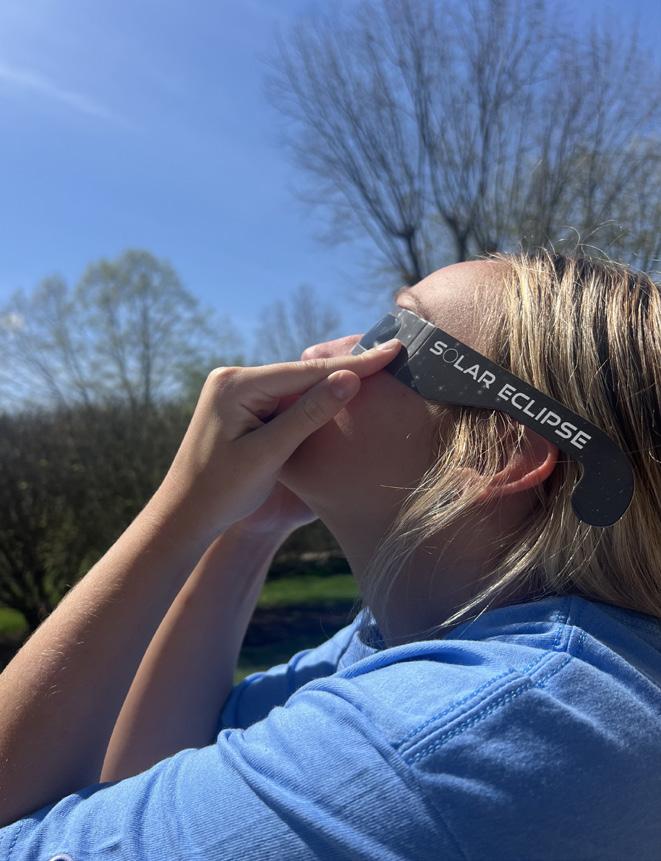

A timeline of previous solar eclipses that occurred in Indiana
2099: Next time a total eclipse will be visible in Indiana
With Earth Day approaching on April 22, students and community members alike joined together to give back to the Earth. Sophomore Layla Green is a member of the Environmental Club and shares her thoughts on why Earth Day should be important to everyone.
“It’s important to refocus on the Earth every year so that the importance of Earth Day doesn’t diminish,” Green said. “The Earth cannot advocate for itself, only warn us. It’s important for us to continue to fill the role as purveyors of our planet.”
Green also describes how a normal person can change the world for the better through their actions.
“Common ways to help the environment would include reducing your carbon footprint and limiting consumption and output,” Green said. “The average person can do things like take shorter showers, carpool, bike, walk instead of driving, go to an environmental club, choose post-

consumer recycled goods and use highefficiency light bulbs.”
Personally, Green has encountered her own favorite way to support a healthy planet.
“My favorite way to give back to the Earth is by being vegetarian, and recycling and using post consumer recycled goods when I can in order to reduce my carbon footprint drastically,” Green said.
Along with Green, sophomore Ana Sofi Valero is also in the Environmental Club, celebrating Earth Day along with her clubmates.
“I believe it is important to celebrate the Earth because it is our home,” Valero said. “It provides us with all of the resources necessary for supporting and sustaining life. Having air to breathe and water to drink are gifts that should definitely be recognized and appreciated.”
Valero also elaborates on how she believes Earth Day should be more largely communicated to the community.
“I definitely do believe Earth Day should be advertised more, because it
Small things everyone can to help the planet Source National Ocean Service
Use long-lasting lightbulb s LED bulbs reduce greenhouse gas emissions and cut energy costs
Shop wisely Buy less plastic and bring a reusable shopping bag to reduce waste
Further your own education to help others understand the importance and value of our natural resources
raises awareness about environmental issues and inspires positive actions for the future health of our planet,” Valero said. “I believe increasing advertisement will help make this possible and implement these changes.”
Similarly, Valero shares how her own favorite part of Earth Day relates to this increased passion for global citizenship.
“The best part of Earth Day is that it brings people with similar passions together and it strengthens the desire for action,” Valero said. “Seeing other people feel inspired to make a difference is another incredible outcome of Earth Day.”
While she sees the potential the holiday brings for global change, Valero highlights different ways society can improve Earth Day going forward.
“I think we can improve Earth day in the future by raising awareness and organizing more events to help out,” Valero said. “Advocating about the global climate crisis can definitely help make a difference as well.”
Look for opportunities to get involved and make a difference in your community
With the Indiana General Assembly session ending in April, multiple education bills are nearing the end of the legislative process
by Nicolas Bowers design by Alex OsburnChanges are all likely to happen as respective bills pass through the Indiana General Assembly.
For Principal David Clark, it means some changes are coming here through new legislation, such as House Bill 1380.
“House Bill 1380 is a big bill,” Clark said. “It’s one of those conglomerate-type bills that everybody pitches in a little bit, and before you’re done, it’s this really huge bill with a lot of content in it.”
Clark emphasized the variety of the bill, and how it covers many different topics.
“It includes a lot of things, everything from youth apprenticeships to special education laws,” Clark said.
When looking in on the part of the bill that mentions special education, Clark elaborated on how seclusion can be defined in comparison to other methods of handling certain situations.
“Seclusion is when you put a student away to isolate them, while time out is where they’re still visible, they’re still around,” Clark said. “They just need some time to cool off or let the dust settle a little bit.”
To help create an environment where all students feel safe and respected, select staff go through extra training to help respond to crises.
“All of our principals and some of our special education department have all been trained in what’s called CPI, which stands for crisis prevention intervention,” Clark said. “We’re trained in how if there’s an issue with student behaviors that might turn bad, violent or get out of hand, we know how to restrain a student without harming them, all while maintaining their dignity, and keeping other students safe.”
Another bill, Senate Bill 282, has recently been passed and became a law. It focuses on school attendance, and gives schools new options when a student repeatedly skips class.
“Once a student hits so many absences,
we have to turn it in and send a report to the local prosecutor,” Clark said. “It doesn’t say they’re going to do anything with it, it just says we have to send the information there.”
For the administration, it’ll change some day-to-day activities when reporting attendance.
“It’ll change some of the reporting that we have to do for students who are less active in terms of their attendance,” Clark said.
English Teacher Kelley Culp, a member of BCSC’s committee on making a new electronics policy, explained the components of the bill.
“The bill requires each school corporation and charter school to implement a wireless communication device policy that governs student use of a wireless communication device; and also publish the policy on the school corporation’s website,’” Culp said.
The goal of the bill is to help make students more focused at school through the use of a more defined phone policy.
“This will allow us to have a very clear, building-wide policy that everyone can enforce and everyone knows,” Culp said. “The policy also affords teachers the ability to regulate what instructional time looks like in their own space.”
Culp emphasizes how the current policy lacks definition and needs updating.
“We already have a policy in our handbook, but not many people follow that policy,” Culp said. “The policy we have been working on updates some of our language and clarifies the consequences for students who do not follow the policy.”
While Culp recognizes the bill will likely get pushback, the goal is to make a better learning environment for everyone.
“In the long run, I think it will help us return to a more engaged student body,” Culp said.
A look at other bills that became laws during this session
HB 1137
Upon written request from a parent, a public school must let a student out of school to attend organized religious instruction
HB 1073
Schools would have to install security cameras in special education classrooms, sensory rooms and seclusion spaces
SB 185
School districts and charter schools must adopt certain policies that limit students’ access to smartphones in the classroom
SB 282
Schools must report students who miss more than 10 days of school unexcused to both their parents and a prosecutor
The Wizard of Oz production participants described their preparation for the musical by
Liz Carrigan design by Jocelyn Aguilar photos by Alex OsburnThe curtain rises and spotlights illuminate the actor’s eager faces as music fills the ears of the audience. All of these elements that members of the audience see are only a small glimpse into the effort that goes into each production, and North’s production of “The Wizard of Oz” was no different. The performance nights are only the tip of the iceberg when it comes to the work that is put in to make a production run smoothly. Junior Olive Mantooth who played the Wicked Witch of the West details what the preparation process looks like for actors.
“Preparing for the musical is a long process. To start out, we have to learn our blockings and stage directions, then we are taught the music and dances for the music numbers and the actors work on memorizing lines,” Mantooth said. “As we start to get everything down and memorized we should run through the show, work on any trouble spots and keep on trying to make it better with each run through.”
Sophomore Annabelle Andrus, the costume master, communicates her favorite part of theater.
“My favorite part of theater is that it allows you to find people who share common

interests as you,” Andrus said.
Additionally, Mantooth explains her favorite part of her involvement in theater.
“My favorite part of theater is performing and the friends that you make after working so closely together for so long,” Mantooth said.
“The Wizard of Oz” is a production with distinctive scenes and set pieces. Director Robert Deirth illustrates how this musical differs from others.
““The Wizard of Oz” is a classic. So many people have grown up with Wizard and know the great story and songs. It is one of the most commonly done musicals, and that is with good reason. It has great songs and dance, but also a great plot,” Deirth said.
Every musical has many moving parts, and each person plays an important role. Andrus outlines what her role in “The Wizard of Oz” looked like.
“My role is costumes master. Along with my costumes assistants, we work together to make sure everyone looks good on stage and looks like their character,” Andrus said.
Deirth expresses what his role was in the musical.
“My role in “The Wizard of Oz” production is that of the director. During practice, my

primary responsibility is to help coordinate the actors on stage helping them to work better as a team and individually in their performance,” Deirth said. “Additionally, I coordinate the efforts of the musical director, the choreographer, the technical director and the conductor to bring the production together. Putting together a musical in about two months is a large undertaking and takes a team of staff and students moving in the same direction to make a quality production.”
Theater combines many different character aspects including passion. Deirth shares why he’s so passionate about theater.
“My passion for theater stems from the way it combines so many disciplines together. This allows theater to be welcoming to people with diverse interests and skill sets and bring them together as a team,” Deirth said. “We have students who excel in the performing aspect , but we also have many others that operate the lighting and sound systems, design and manage props and costumes, build the set and even manage the show backstage. Being an educator, I can see how much valuable knowledge and experience can be gained and shared from all of these areas. Theater is something anyone can enjoy and find an important role within.”
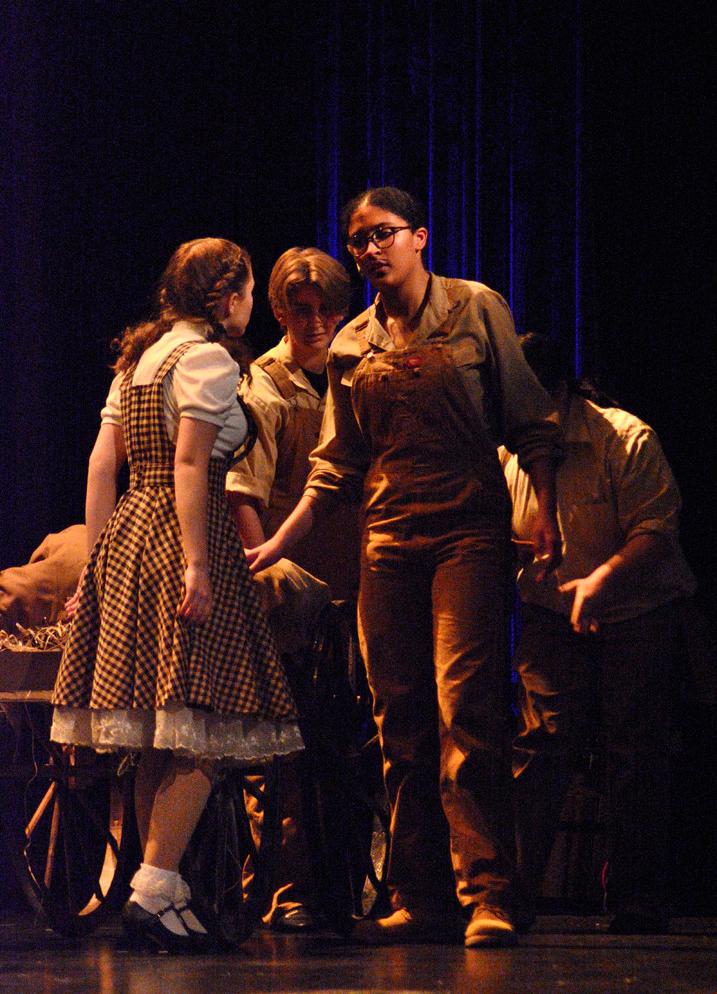
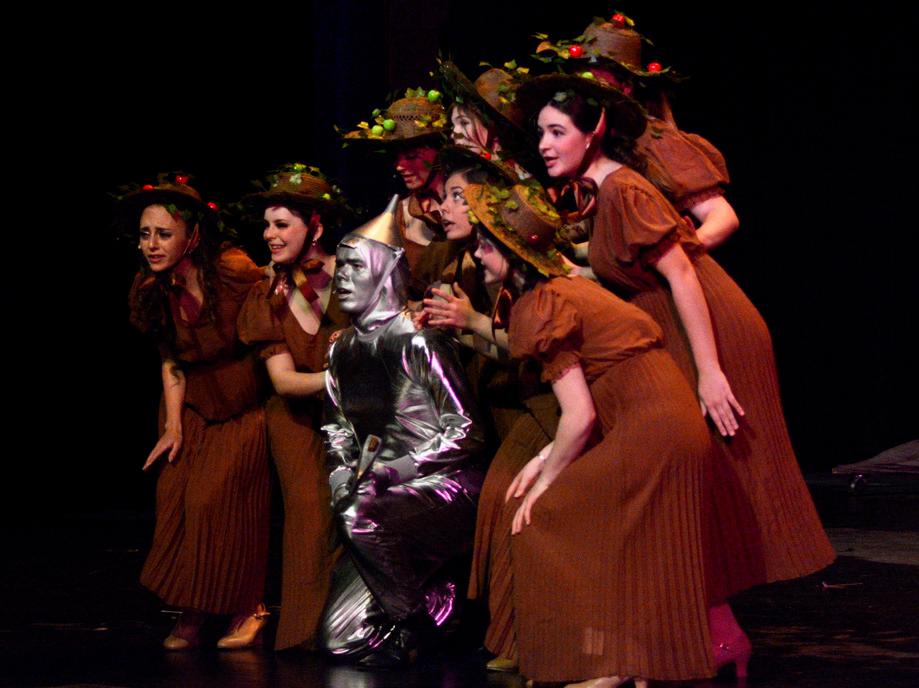



Freshman Alyssa Maddox plays the Mayor of Munchkinland.
Freshman Gabe Manning and senior Caroline Andrus play Uncle Henry and Aunt Em.
Senior Amelia Maddox as Dorothy and senior Annie Miller as Hunk.
The trees and Austin Clark (Tin Man) perform the song “If I Only Had a Heart.”
Junior Olive Mantooth plays the Wicked Witch of the West.
Senior Amelia Maddox (Dorothy) and sophomore Cage Elliott (Scarecrow) trip across the stage.
Senior Joe del Genio walks across the stage as the Wizard of Oz. 4 5 6 7 1 2 3 4 5 6 7
The
class put on a fashion show to exhibit their classworkby Cecilia Gutierrez design and photos by Claire Davis
On March 22, the East cafeteria was turned from a place where students eat to a place where students’ work is exhibited: a runway for a C4 fashion show.
“We made it all look like a runway,” C4 fashion and textiles ambassador senior Molly Bray said. “It looked really cool.”
However, turning the East cafeteria into a runway show came with unique challenges, as the fashion show was much more than a fashion show: it was the result of hours of work, months of coordination and a great deal of collaboration. Not only does the C4 fashion show exhibit the work of the fashion and textiles class, it is also the work of C4 cosmetology, who did hair and makeup, and C4 business, who did marketing.
The C4 fashion and textiles has been a class offered for a while, but it only became a pathway this year.
“Because there were new standards, we were able to make that happen, which is incredible because students can actually graduate taking the Core 40 classes and taking the fashion classes,” Bray said. Bray has been in the Fashion and Textiles program since starting at East as a sophomore, taking the semester classes offered. But as the desire for a bigger class grew, the changing standards allowed for
a change that would shift the way the C4 Fashion and Textiles classes functioned. Thanks to the changed standards, and the work of Fashion and Textiles teacher Amanda Godwin alongside her students, the class became a year-long C4 pathway. The Fashion and Textiles pathway offers real world fashion experience for students such as junior Libby Richards.
“[I learned] time management just because it was a lot of work in a shorter amount of time than what we’ve been doing for most of the year,” Richards said. “Also, it just helped me work on my skills more, such as working on dresses and such.”
The fashion show was a five-section show. The five sections included Prom, FCCLA, ‘Designed by You’, Thrift Flip and Trashion.
The Prom section included dresses designed and styled by students. But not only were these dresses used for the fashion show, they also had another cause. On March 29, the Bartholomew County Public Library was giving away Prom dresses, both from the fashion show and other sources, for completely free, as the coordinators believe that everyone should have an outfit for Prom that makes them feel good.
The second section included dresses taken to state through the Family Career and Community Leadership of America, or FCCLA. These dresses included designs


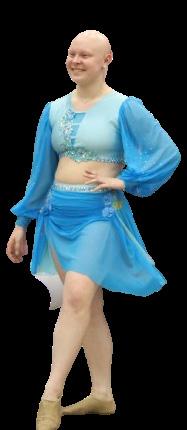

made by Bray and Richards, among others.
‘Designed by You’ included outfits styled and designed by students. Some students designed dresses and others made or styled outfits. Richards used her FCCLA dress, a red satin and chiffon dress.
The fourth section was Thrift Flip, a section that had students recycle thrifted finds into something new. Bray created a ballgown out of a maternity suit.
The final section of the show was called Trashion. This section challenged students to make outfits out of things that would usually be deemed trash. Some of the designs students came up with included a Coca Cola corset, paint sample dresses and a coffee filter dress.
The C4 fashion show was not only a way to show off student’s fashion and textile skills, but it was also the accumulation of years of dedication, coordination, collaboration and motivation, both on Godwin’s part and the students’. Because of the newly created pathway, future fashion enthusiasts can continue to put on fashion shows that give the community a reason to support the present and future of fashion.
“I thought it went well,” Richards said. “I was a little worried because we didn’t do much practice with it. I think it came together pretty well, especially for it being the first year.”


Student assembly elections happened in advance for next year
by Lois Guest design by Jaedyn Greenlee
Fill out application at end of the school year found in the office General population of school votes If not voted on, you can work on
Fill out application at the end of the school year General population of school votes If not voted you don’t get a guaranteed spot on assembly
At the end of every school year, current members and hopeful members of student assembly and student council apply to be a part of the following year’s organization. Freshman class president Liam Glyn-Jones was inspired to join student assembly at his freshman orientation when he saw the current class president and vice president.
“During eighth grade night or freshman orientation, I’m not sure which one, I saw Fisher and Frankie at a table advertising student assembly,” Glyn-Jones said. “I knew them from cross-country and Winter Warriors, and I thought student assembly looked fun.”
Glyn-Jones likes being able to participate in specific school activities during student assembly.
“I really enjoy the people and how I can get involved with the school,” Glyn-Jones. “I like helping the community, students and teachers.”
Similarly to Glyn-Jones, sophomore Gabby Spurgeon was recommended to join assembly by some of her peers.
“I knew a lot of people who were already on [student assembly] and I saw a lot of opportunities to give back to the community,” Spurgeon said.
Sophomore Noah Palmer is the vice president of the sophomore class. He has enjoyed building relationships in student assembly.
“My favorite parts of assembly are the community, the atmosphere and meeting new people,” Palmer said.
Being a part of student assembly requires a commitment to weekly meetings, after-school activities and weekend activities.
“For me and those on council, we are doing student assembly work every day in advisory. For the rest of assembly we have lots of time commitment after school and on weekends,” Glyn-Jones said. “It isn’t something that can be done last-minute or halfheartedly.”
At student assembly meetings, upcoming events like school dances and theme weeks are commonly discussed.
“We discuss everything from different themes to how many tables we need for formal,” Glyn-Jones said. “A lot of thought and time goes into each thing behind the scenes.”
Decisions involving changes to traditions are also likely to be discussed during assembly meetings. For example, the annual tradition of the winter formal dance is being changed to a homecoming dance next year.
“I am looking forward to moving the formal dance to homecoming week,” Palmer said.
Palmer ran for his goal position of being president for his upcoming junior year. He describes how being known by one’s peers is essential to being elected.
“The elections are competitive, but it’s very exciting,” Palmer said. “To be elected you have to be well-known.”
Running with Palmer as vice president, Spurgeon looks forward to continuing to be a part of assembly in the coming years.
“Next year I am looking forward to working together with people and being the leaders of the school,” Spurgeon said.

With senior year coming to a close, I share my past experiences and wishes for the future
by Emma WarnockIn a little over a month, the class of 2024 will walk across the stage and receive their diplomas. In 36 days, an entire class of joyful, sorrowful, confident and reluctant individuals will cross a stage in the gym and say goodbye to the only community they have ever known. Some people in this class will go on to make a name for themselves, achieving everything they have ever dreamed of doing. They will make their parents proud and live a life with no regrets. Others will never be fulfilled with their life, pining for the former glory days of high school. None of us know what will happen in the future. All we have is the here and now.
As I look back on these four years, I have more regrets than I should. More of my nights were spent fretting at home rather than enjoying these brief years in limbo between childhood and whatever is to come. These special years where anything is possible, but so many things are out of reach, where we can walk the tightrope with no fears, knowing that there will be a safety net at the bottom.
Now in these final weeks, views of Prom plans and Senior skip day are obscured by the tattered shroud of adulthood looming over every decision I make. Does any of this matter when my entire future is a mystery? Who will I become when I know that all of my dreams won’t come true? How do I keep my head above water when every ‘what if?’ constantly tries to suffocate me? All of these unknowns rattle around in my head, screaming relentlessly to be heard. But then again, all we have is the here and now. Here and now, we have the whole world in our hands. Here and now, we have each other to lean on. Here and now, we have people in our corner to help us grow. We must preserve this moment in our memories because here and now will soon turn into the good ol’ days.
I hope, as I sit in that room crowded with hundreds of my peers who will forget my name in five years, that something will be remembered of that morning of graduation. We are living the last days of our adolescence. We are being sent off into a dark chasm of unknowns without any light within us. The only way to make it out alive is to take the memories of all of that joy, sorrow, confidence and reluctance within ourselves and ignite it, to create a spark to illuminate even our darkest days.

Billie Eilish has been killing it recently with her Grammy wins, Oscar awards and upcoming album. All of these successes, along with her unique style, have made her my personal favorite artist. So what’s the big deal?
Eilish has become one of the biggest stars in the U.S. today in a relatively short amount of time. Currently at age 22, she has two studio albums, her most recent being “Happier Than Ever,” which had over 300 million streams on Spotify as of 2023. Billie’s full name is Billie Eilish Pirate Baird O’Connell, which is something I didn’t realize and found to be interesting while learning more about her. After her single “ocean eyes” gained popularity in 2015, her career sparked into what it is today. Recently, she won not her first, but her second Oscar for Best Original Song after her hit “What Was I Made For?’’ was released and used for the “Barbie” movie.
At the beginning of April, Eilish had roughly 111 million followers on Instagram, and it rapidly grew to 120 million in the span of days. Her following erupted after she added all of her fans to a “close friends story.” This both excited and drew fans to anticipate the announcement of a new album. They didn’t have to wait long, because on April 8, she officially announced her brand new album which comes out on May 17.
Personally, I’m very excited for the album. The teaser she released about it is very cool, as the new album cover ties into the end of her song “Happier Than Ever”. In that music video, she is seen jumping into water towards when the song ends. What makes this so interesting is that the album cover of her new album is her sinking in that same water.
As much as her successes are important to understanding why she is so popular, my favorite thing about Billie is her unique style. Photos of her at the Grammys, Met Gala and various other awards ceremonies feature her wearing designer clothes and abstract designs. Not only does she wear interesting items, she also dyes her hair quite frequently. During her “Happier Than Ever” era she was blonde, but back in her “Bad Guy ‘’ era she had her iconic black hair with green roots, which is what most people remember her for.
Overall I love Eilish’s albums and her music. If you haven’t listened to her, I would highly recommend it. Her continued success is fun to follow and I hope her next album doesn’t disappoint.

With so many senior citizen politicians, it’s time for age limits for governmental positions
by Nicolas BowersJoe Biden. Donald Trump. Nancy Pelosi. Mitch McConnell. These are all people either currently serving as the president, are in Congress or are campaigning for the upcoming election. However, they’re all in their late 70s or 80s. In my opinion, that’s insane.
According to Pew Research, the average age of a senator is 65. That is the retirement age for millions of Americans, largely because that’s when Medicare starts. Again, that’s ridiculous.
Last September, Senator Dianne Feinstein died in office at the age of 90. In 2022, Don Young of Alaska died in office at the age of 88. In 2021, Florida Representative Alcee Hastings died in office at the age of 84. The list goes on and on. Our politicians don’t reflect our country. So many of them have been in office for decades upon decades.
I believe that it’s time for new voices, new leadership and new ideas. I believe that it’s time for age limits in government.
First, it would give Americans new leaders. Leaders who have families, leaders who are relevant and leaders who understand the world today not only politically, but also socially and culturally.
It would also force politicians to retire. I think it is simply wrong that we have people in their 80s and 90s in government. They have worked so hard for many decades, and they deserve to enjoy their lives, unburdened by the stress, drama and responsibilities of politics. Additionally, I believe that it would help our image across the world. It is quite frankly embarrassing that at diplomatic conferences across the world, there are leaders in their 30s, 40s, 50s and 60s, and then there’s the United States with our senior citizen presidents.
For the past seven years, and almost certainly for the next five years, we’ve had presidents in their 70s and 80s. We have a rematch of the 2020 election with Joe Biden and Donald Trump competing against each other for the presidential office again. Both of them have shown age-related speech issues and flaws.
For the safety of our people, our leaders and our role in the world, we need age limits. Without new leadership, our country falls behind.

Would you rather write an essay in a day or in a week?
by Cecilia GutierrezI, like many people, have had a fair share of essay writing, both traditional and timed, and every time I write any of them, I always wonder “is a timed essay better than a traditional essay, or vice versa?”
Writing an essay in a week could mean a week of worrying, days of checking and editing, and all for the fear that your essay is still not good enough. You could spend days checking and checking, hours of revising and obsessing over the smallest details of an essay that most people would overlook. Then you turn it in. You take a sigh of relief as you hit the ‘submit assignment’ button on Canvas and watch as the confetti flies on your screen. It’s over, after a week of lingering stress over an essay that has been submitted.
On the flip side, a timed essay is the stress of a traditional essay, but all within the time frame of around forty minutes. You have to think about it, write it and revise it, or do as much revising as one can in less than an hour.
But which of these fates is better?
In my opinion, timed essays are far better than any traditional essay. When writing a traditional essay, I find it very easy to get distracted and procrastinate, but then proceed to stress extensively about the essay. I could spend days not working on it, but then remember that I have to actually finish your essay. I also get more time to prepare your essay, which gives you more time to revise it- which is a good thing… right? This is a two way street: on one hand, a week of writing and revising would make the essay perfect, but in reality it either results in over obsessing about the small details or forgetting the big details. On the other hand, if I were to overlook all the details, there’s not much of an excuse, after all I had the whole week to write the essay.
This is why timed essays are better. You don’t spend a week stressing over the small details; you just stress for the around forty minutes to an hour that you’re given. It takes all the stress of a week of traditional writing and wraps up in less than an hour. It’s a lot of stress, but it’s only for one time, not counting how long it takes to be graded. And there’s going to be mistakes in a timed writing, but you only had forty minutes to do it, meaning that those mistakes are mistakes that any person would make given a time crunch.
Timed essays are simply better. They have all the stress of a traditional essay, but you really only feel the stress for less than an hour. Of course I would rather not write a literary analysis, but I’d rather only have to write an analysis for forty minutes than for a week.
Student assembly explains how High School Heroes benefits the community
by Liz Carrigan design by Maia JamiesonSilent struggles and issues with addiction are prevalent anywhere you go. There is often a heavy focus on the consequences of substance use and abuse in adults, but very rarely does a community stop to focus on the effects these battles have on the children of those struggling with substance abuse. High School Heroes breaks this mold and creates an opportunity for kids to hear about the results of harmful substance use and abuse.
Junior Hannah Sears defines High School Heroes, and explains what the event looks like.
“High School Heroes is a student assembly event where we go around to certain elementary school classes and present to them a presentation on the longterm negative effects of tobacco, alcohol, vaping, and drug use,” Sears said.
Junior Aya Saad shares why she believes High School Heroes is important.
“This is important to raise awareness to rising generations and teach them how to properly say no to addictions,” Saad said.
Events such as high school heroes bring with them excitement. Sears reveals what
portion of the event she is most looking forward to.
“I’d say I’m most excited to see the class, and present to them; I remember being in elementary school and anytime high schoolers came and talked to us it was the coolest thing ever. Being able to be that person for them is awesome.
Sears goes on to reveal some of her favorite parts of High School Heroes.
“My two favorite parts of High School Heroes are seeing the kids learn everything, and going with my group. It’s awesome to see the elementary kids who are usually so crazy, be so respectful and helpful by answering our questions for them,” Sears said. “The groups are lots of fun too, because it’s who you get to drive around the whole time with, and practice the slideshow with… a good group makes it even better,” Sears said.
With any event it’s important to see results. Junior Lindsey Hartwell shares some of the results she has seen from High School Heroes.
“Based on the kids’ interaction and questions during the presentation, we can tell that the kids are understanding the dangers
of these substances,” Hartwell said.
Elementary school students who experience High School Heroes will have the opportunity to return and present to a new generation of kids when they’re in high school. Hartwell shares how she’s come full circle with High School Heroes.
I have been able to benefit from [High School Heroes]. I still remember watching the presentation when I was in fifth grade and I looked up to the high schoolers as a role model to follow,” Hartwell said.
Additionally, Saad spells out the benefits she’s seen from the event.
“High school heroes allowed me to see elementary kids and teach them as they begin to be exposed to these types of addictions,” Saad said.
High School Heroes is a learning experience for all involved. Sears describes what she has learned from this event.
“I’ve been able to learn new information that even I wasn’t aware of before, and I’ve learned many things from presenting, improving my presentation skills too. High School Heroes is so beneficial in many different ways,” Sears said.

Looking into a mirror for the first time as a young child brings feelings of wonder and excitement. The shiny glass holds a constantly changing image of bright eyes and a smiling face. Over time, the light begins to fade out of the eyes and the smile slowly gives way to an emotionless expression. What was once a joyful reflection becomes a magnifying glass for every perceived imperfection and flaw. Every glance brings a stronger urge to take control over the body in the mirror.
As technology develops and becomes more prominent in modern society, it is increasingly common for children and teens to receive smartphones and instantly become connected to the online world. One major component of this online world is social media, which can glorify images of idealized body types and contribute to insecurities and distorted self-images, especially among young minds. One hundred percent of the Triangle staff believes that the way social media has developed has influenced people to develop a poor self-image. Though social media is not entirely to blame, it is a key area to examine when considering the bigger picture of just how many young people are dissatisfied with their appearance, which according to the Social Media Victims Law Center, 78% of girls in the U.S. are not happy with their weight by age 17. Additionally,
Statistics highlighting those who are more likely to suffer from eating disorders and ultimate effects of improper treatment
Source National Eating Disorder Association
research suggests that over half of teenage girls and roughly a third of teenage boys practice unhealthy weight loss behaviors, such as taking laxatives or skipping meals. Social media can play a key role in the development of young peoples’ body image, which in turn presents the opportunity for unhealthy eating habits or the beginnings of an eating disorder.
Along with contributing to distorted self-images, social media platforms can also create an idea of how other peoples’ bodies can or should appear. Eighty-seven percent of the Triangle staff think there is a stereotype about what a person with an eating disorder looks like. According to Foundations Counseling, “When most people think about someone with an eating disorder, they picture a person who appears unhealthy and emaciated. Many people who have eating disorders have a normal weight, and many are even larger-bodied.” This societal preconception of what an eating disorder “looks like” can lead to a dangerous cycle where some people struggling with a disorder are dismissed by their peers because they do not fit the stereotypical expectations of someone who has such a disorder.
Those who are struggling with a disorder can additionally be dismissed by medical professionals. Seventy-nine percent of the Triangle staff believes that a doctor’s personal opinions can affect the treatment
Eating disorders occur in an estimated versus of women of men 8.60% 4.07%
6% Less than of people with eating disorders are medically underweight
of a patient. A report done by an Institute of Medicine panel concluded that “racial and ethnic minorities received worse health care than nonminorities, and that both explicit and implicit bias played potential roles.” Even if doctors are unaware that they are treating patients differently due to racial factors, these unintentional treatments can lead to unresolved issues that are unknown to anyone since the patient and their family are under the impression they’ve done everything they can.
Beyond doctor’s personal opinions, type of insurance and socioeconomic status can affect both a patient’s treatment and overall probability of developing an eating disorder. According to the National Library of Medicine, those who are of lower socioeconomic status show eating disorder behavior at a faster rate compared to those of higher socioeconomic status. Whether a patient has public insurance or private insurance has also shown a difference in treatment. Ultimately, when analyzing how social media can affect people’s self-image and how a doctor’s opinion and socioeconomic can affect patients’ treatments it’s clear that those who suffer from an eating disorder are surrounded by an environment that is unable to provide the proper support that is needed in order to be able to recover.
People of color with eating disorders are half as likely to be diagnosed or receive treatment
Eating disorders have the 2nd highest mortality rate of all psychiatric illnesses
Looking into a high schooler’s perspective on eating disorders and body image
by Izzy Munn, Sylvia Sasse, Deshna Venkatachalam and Lydia WeedCommon disorders and their definitions
Source American Psychiatric Association
Characterized by self-starvation and weight loss resulting in low weight for height and age
Typically alternate dieting, or eating only low calorie “safe” foods with binge eating on “forbidden” high calorie foods, then compensated by vomiting, fasting, exercising or laxative misuse
Similar to bulimia, without methods of compensation following binge eating episodes
A disturbance in eating resulting in persistent failure to meet nutritional needs and extreme picky eating
The following content contains material about eating disorders, depression and suicide that may be upsetting to some readers
“Something is up, we haven’t seen her in forever.”
“Every time we see her, she gradually gets smaller.”
“Something is up, we haven’t seen her in forever.”
“Every time we see her, she gradually gets smaller.”
These are the words spoken by senior Elise Preston’s friends. Her concerned friends did not know what she was battling, but they knew something was going on beneath the surface.
In July of 2022, Preston was admitted into an eating disorder recovery center. She was a patient there for a year and a half.
“My family noticed first, and a lot of outside friends and family were the ones that were contacting my parents,” Preston said. “Then my parents finally made the executive decision to admit me to the center. About a week later, I was admitted to the hospital because my heart rate was too low. So then I was on bed rest for about two months.”
According to the National Association of Anorexia Nervosa and Associated Disorders, an estimated 9% of the US population, or 28.8 million people, will be diagnosed with an eating disorder in their lifetime. However, Rebecca Owens, a psychiatric mental health nurse practitioner, states that 80% of eating disorders go undetected or untreated. Preston was a part of the 20% that was able to get treatment and explains how it felt at the time.
“[My eating disorder] was very mentally challenging for me because no one really understands unless you’ve been through it,” Preston said. “It is a very personal topic and most people don’t feel comfortable talking about it, but I think it’s something that needs to be talked about more. Recovery is an incredibly hard thing to do and you need your support system around you.”
While Preston’s recovery process was prompted after others noticed, her journey of battling an eating disorder began earlier on.
“I think that social media was probably the first thing that triggered me by seeing everyone’s photoshopped bodies. It’s hard to figure out that that’s not who they are,” Preston said. “You could pose in whatever way you want to make the camera angle look better and make your body look the way you want. There are so many apps now that make you look incredibly different than what you look like.”
One of social media’s purposes can be to share photos and videos of oneself and their experiences, however, for Preston, it had become a distorted reality. Preston explains the feelings that arise from this.
“I feel like eating disorders make you feel more alone,” Preston said. “You’re kind of in your own space and there’s not much you can do to get out of it.”
The next step of Preston’s journey is to recognize the loneliness that arises from mental health issues and be a voice and companion for those who are struggling.
“I kind of wanted to be that person that people could come to and talk to because I know [how it] feels [to be] alone during that time,” Preston said. “I feel like it’s important for someone to see someone that has actually gone through it and made it out to the other side.”
Preston’s passion for advocacy in relation to positive mental health and fighting against eating disorders was a driving factor in her senior project.
“My senior project is mental health based because I’m in the Project Lead The Way program. I decided to [sell] shirts and bring awareness around mental health,” Preston said. “[My senior project] stemmed from my eating disorder, but also my eating disorder brought depression and some suicidal thoughts. I wanted to make sure people knew that every single part of mental health matters.”
A study conducted by the University of Massachusetts found that one in five teens may struggle with disordered eating behaviors. Dr. Christy Duffy, Ph.D., a psychologist who specializes in eating disorders, explains the age at which eating disorders typically develop.
“Eating disorders often begin during middle school and high school years, and food and body concerns are extremely common during this phase of life,” Duffy said. “It isn’t actually normal for teenagers to experience worries about eating and appearance. It’s not a natural thing. But in our culture, it is very common. While eating disorders are often identified as categorical, they are actually on a continuum. It can be a fine line between maladaptive eating patterns and a full eating disorder.”
Despite being common in adolescents, Duffy elaborates that there is no direct path a disorder evolves from.
“Sometimes they will start gradually, often with the onset of counting calories or restriction via dieting,” Duffy said. “Other times they will hit with greater force and become more severe in a short period of time.”
As reported by the National Institute of Mental Health, the most commonly diagnosed eating disorders are anorexia nervosa, bulimia nervosa and binge eating
disorder. Bulimia nervosa and binge eating disorder both consist of an excessive intake of food within a short period, however, bulimia ends with a purge, or a forced way to get rid of the food. Anorexia nervosa is characterized by a reduction of food intake and also has the highest mortality rate out of all eating disorders. Duffy explains how the early signs of an eating disorder can be difficult to recognize at times.
“The warning signs of an eating disorder and the behaviors that are common in our diet-focused culture are often very similar,” Duffy said. “It is a common misconception that you can look at a person and tell if they have an eating disorder. Early symptoms of an eating disorder typically involve restricting intake, engaging in dieting behaviors and focusing on eating.”
As stated by the Mayo Clinic, most doctors agree that mental disorders stem from a combination of genetic factors as well as one’s surroundings. This can also be true in some cases regarding eating disorders.
“There may be a genetic component to eating disorders, however, what is more clear is that they are familial in nature,” Duffy said. “This means that when one person in a family has an eating disorder or has suffered from one in the past, others are more likely to develop an eating disorder. This is common in mother-daughter relationships as well as with siblings.”
The process of treating eating disorders can be complex, which can make tailoring treatment to each patient more effective. Duffy explains how many factors help a patient in their recovery.
“Eating disorders typically require a multidisciplinary approach to treatment. Because eating disorders are inherently multisystemic, providers are needed to

assess and treat each component,” Duffy said. “It is common to have a therapist, dietitian, physician and psychiatry provider involved.”
Recovery can be a non-linear process. According to a study published by the Journal of Eating Disorders, patients are at their highest risk of relapse during four to nine months after discharge.
“Because eating disorders are difficult to treat, relapse is not uncommon. However, it depends on how we look at relapse,” Duffy said. “There will be setbacks and a return of previous symptoms. Once in a solid recovery, relapse can be managed with a solid awareness of risk factors and triggers, as well as the use of regulated intake and healthy coping skills.”
Duffy describes how one of the most difficult stages of recovery from an eating disorder can be changing the perception of one’s body.
“Body image is typically that last, and often the hardest piece of recovery. A focus on body image most often is not actually about the body,” Duffy said. “It’s more often about perceived safety and lovability in the world.”
Expectations set in society about body image can differ greatly between males and females. For example, one male student explains the perception of men’s expectations in this society.
“The beauty standards for males just means bigger and stronger guys,” the male student said.
For this male student, his body image and the beauty standards placed on men is something he does not have to worry about anymore.
“It did affect me when I was younger, but not now. When I was younger I was a lot plumper and I kind of looked down at

812-900-2613
812-900-2613
SUICIDE AND CRISIS HELPLINE
812-900-2613
myself,” the male student said. “But I just kind of accepted who I was and my body image doesn’t affect who I am now.”
However, this doesn’t mean he isn’t concerned about his body image and takes steps to maintain it.
“[Gym culture] has prompted me to work out more and take control of my body instead of not doing anything about it,” the male student said. “It can be toxic, but it just depends on who you’re with. Most people don’t care where you’re at in the gym and they’ll always support you no matter what.”
While the gym is a way for one to maintain and reach personal goals, previous circumstances have required him to focus on his body image to meet the goals of his sport, wrestling.
“During the wrestling season, I was trying to cut weight,” the male student said. “I would always look at myself and figure out if I was improving and making sure I was where I wanted to be.”
Senior wrestler Lilly Breedlove explains how weight impacts the sport of wrestling.
“Weight classes are divisions based on wrestlers’ body weight,” Breedlove said. “As a wrestler, you want to stay consistent on weight and sometimes maintaining that can be hard because you can’t be under or over the day of a match.”
Bulking and cutting are the two ways wrestlers meet their weight goals. Bulking is a method for gaining weight in which one eats more calories than one burns while focusing on intense weight training for a certain amount of time.
“I’ve bulked outside of wrestling but never in season and I’ve cut in wrestling just a little bit to maintain my specific weight.,” Breedlove said.
Even though it can be done healthily, Breedlove explains the struggles that come along with maintaining weight during the season.
“I’ve only heard a few comments about my body based on what I’ve been told. [However] I do think to a certain extent it’s not healthy to bulk or cut,” Breedlove said. “I feel pressure to maintain a certain weight because it’s also embarrassing to miss [weigh-in]. And most of the time if you miss weight they don’t let you compete.”
Similarly to the male student, Breedlove also goes to the gym and has personal goals that differ from her wrestling expectations.
“I love going to the gym and I like having a healthy diet,” Breedlove said. “I have my own goals to reach in the gym but the gym and diet now are very different from [my] wrestling diet and exercise.”
While both the male student and
Breedlove have positive gym experiences, social media can create heavy gym expectations. While scrolling through “#GYMTOK” on TikTok, posts of the “ideal” body type are presented. Guys with muscular arms and girls with toned physiques are seen on the most liked posts. Preston explains why it’s important to embrace oneself over creating comparisons.
“You don’t need to compare yourself with everyone because it does way more harm than good,” Preston said. “Follow people that bring you happiness and joy and not people that make you feel incredibly bad about yourself.”
Body image can be an umbrella among students. There are many struggles that lay beneath it. While Preston has recovered, her journey hasn’t ended there. From her learning experiences, she advises those struggling with their mental health and eating disorders.
“Do not feel afraid to reach out to people. People are out there to help you, even if they don’t understand what you’re specifically trying to say. Just having someone to listen and to talk to is really important to get you through it,” Preston said. “I promise you are not alone and there are always people who want to help. Be transparent with people that you love.” THE NATIONAL ASSOCIATION OF
As the cool spring breeze flows through the air, a lacrosse player’s younger sister watches him play. Immediately, the game catches her attention and after the game, she asks to sign up for the upcoming season. However, there is no team for girls lacrosse. When she enters high school, a girls lacrosse team opens up at the school, and she immediately signs up as memories from watching her brother play come back to mind. As soon as she starts playing, however, she realizes how different girls lacrosse is from boys lacrosse. Despite facing such an extreme difference, she perseveres and falls in love with the sport. Senior Kate Ellis had the opportunity to join the newly created girls lacrosse team freshman year and also fell in love with lacrosse, despite initially being hesitant to join.
“I think [my favorite part is] just the team,” Ellis said. “Everyone on the team was so supportive. The first practice
I came to, everyone was so welcoming and it was just really like ‘Wow, this is so much fun.’ I really did just like the sport and I fell in love with it really quickly.”
Similarly, junior Reid Chapman decided to join lacrosse this year and has found his own favorite part.
“[I love] the culture between the programs,” Chapman said. “I think a lot of players are fun to hang out with.”
Even though both boys and girls are able to play lacrosse and find aspects of it to fall in love with, the two sports are very different, as senior Eddy Lin mentions.
“The two sports are very different and they can kind of be categorized by themselves,” Lin said.
As an experienced player, Lin is able to describe a few of the specific differences between boys lacrosse and girls lacrosse.
“For the most part, there is not really a lot of contact [in girls lacrosse],” Lin said. “For guys, we’re allowed to hit each other pretty bad as well, just like

metal sticks hitting your arms. For girls, I don’t know if they’re called penalty shots, but they kind of wind-up and get a free shot.”
Ellis is able to elaborate further on these rule differences.
“I know for sure that girls [lacrosse] has no contact at all, and in boys [lacrosse] they can hit, they wear all padding and girls only have goggles to defend them from anything,” Ellis said. “So you’re not supposed to hit anyone at all. There’s a lot of differences in fouling and stuff like that because guys can do a lot more with their sticks.”
Junior Daniella McNeil joined lacrosse this year and talks about how she feels about the rule differences between boys and girls lacrosse.
“I mean, I guess from a biological standpoint it makes sense that we have to be less aggressive, but I also wish we could be more aggressive,” McNeil said. “I got a few fouls [last game] for being too aggressive.”
Alternatively, Chapman
is able to bring a different perspective to the rule difference.
“Some people might differentiate between men and women,” Chapman said. “I don’t really see a problem in that, but I think other people do.”
After gaining experience in the sport for four years, Ellis is able to talk about her opinion on how people react to the differences in boys and girls lacrosse.
“I think it’s definitely interesting. It’s something you would think about and kind of be like, ‘well why isn’t girls any contact at all?’” Ellis said. “It’s kind of that idea. It is hard too, because people come to girls games and a lot of the time I’ve gotten so many comments, about like ‘well it’s so much easier, you don’t have to do anything, you can’t even hit each other,’ and I think a part of that is just guy versus girl thing. Which sucks, but I mean honestly the sport is hard, I’ve played it, I know it is, so it doesn’t affect me that much.”



MISSION: Promote Excellence at CNHS for Students, Faculty, and Alumni by providing:
• Scholarships and Student Assistance Grants
• Teacher Appreciation Program and Faculty Assistance Grants
• Alumni Communication Channels and School History
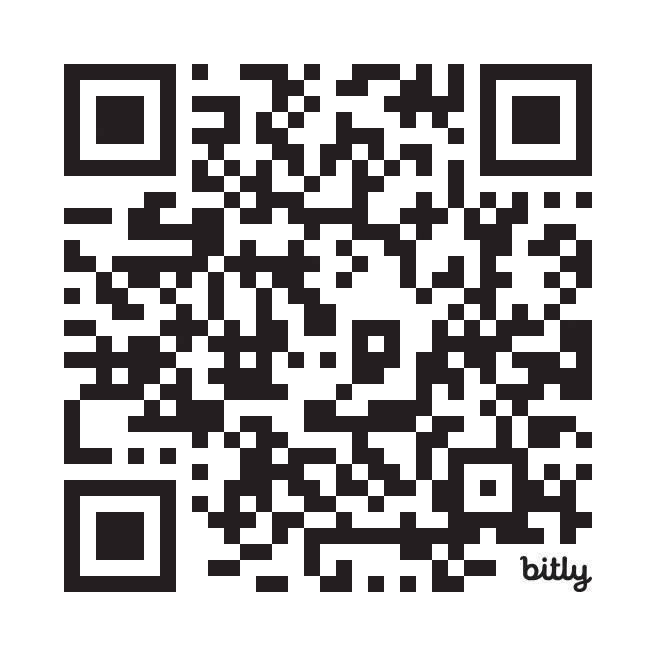
STAY BLUE: Fill out the Google form using the QR code or bit.ly link below
FREE: Sign up for our e-newsletter at True Blue sign-up or use our website columbusnorthalumni.org
Join our Facebook page @Bull Dog Alumni Association
Cheerleaders explain the week-long tryout process
by Stella GaylordFootball. Basketball. Track. Tennis. All of these are examples of sports that only compete for one season. However, there is one sport that is active at games and competitions for an entire academic year: cheerleading. Ranging from motivating a crowd to start cheering to competing at a competition of their own, cheerleaders have to start their tryout process in the previous school year in order to properly prepare for the upcoming seasons.
Freshman Harper Andresen has been through the process before, but she still feels the pressure to impress the coaches during tryouts. “The hardest part is not knowing how good everyone else is going to be,” Andresen said. “There can be a lot of people.”
Leading up to tryouts the team hosts clinics. Anyone wanting to try out later in the week goes to the clinics and is taught the cheers and dances. There are around 70 people who attend the clinics. Junior Reese Euler describes how she felt at the clinic.
“It’s a lot of people at clinics so then you see them at tryouts and you just get kind of overwhelmed sometimes,” Euler said.
Euler describes how it can be a struggle to learn everything on time when given only a few days to learn almost entirely new cheers.
“Making sure you know all of the right material and especially going into tryouts you don’t want to think about like messing up but you’re always just comparing yourself to other people like ‘Am I gonna know it?, Are they gonna know it?’,” Euler said.
Cheer tryouts is a process that lasts a week, which starts with a google form, as
freshman Kennedy Caplinger describes.
“They send you a google form saying like all the stuff that you need to know. Like what they are going to score you on basically.” Caplinger said. “Then there are the cheer clinics, where the cheerleaders are taught the dances, sidelines and floor cheers.”
Euler emphasizes how the cheer clinics are essential to learning all the material required later in the week at tryouts.
“We have clinics two times a week and in the first clinic you just kind of learn all the material,” Euler said. “So it’s just like learning all your material and then you can just practice it at home and then on the second day of the clinic.”

“I love the environment and the people and the coaches.” Caplinger said.
Caplinger highlights how the last step and scariest step of the process is the actual tryouts. “You go into the big gym and you all sit on the floor and watch people tryout.” Caplinger said.
Once the decisions are made and the team has been selected, the season begins. Caplinger explains that the cheer team not only provides a fun supportive environment for the fans during the games but there is also one created for the cheerleaders during practices.
1
Cheerleaders get sent a google form with requirements and what they will be assessed on later in the week.
Whether transitioning from middle school to high school, from club to school, or from never doing a sport to trying something new, Andresen gives some advice for those who worry that trying out for the cheer team can be scary.
“I recommend just going over and over the material and doing it with other people who are trying out,” Andresen said. “They look for lots of spirit so it’s good to know that. There are lots of sports and things at North so if you don’t make it there are lots of other things to do.”
The different steps in the cheerleader tryout process
At the first cheer clinic, cheerleaders are taught the dances, sideline cheers and floor routines for the year.
2
3
The second cheer clinic is used for practice, review and memorization
Cheerleaders report to the main gym for official tryouts. They are then assessed on their skills.
4
For athletes and helpers alike, unified track provides the opportunity to get exercise, learn lessons and have fun.
Junior Lindsey Hartwell is a helper for unified track, and was inspired to join by her family.
“My sister did unified track and I wanted to try it out because I knew a lot of my friends were doing it, so I knew it would be fun,” Hartwell said.
Similarly, junior Morgan Johnson was also inspired by others to be a helper.
“One of my friends was doing [unified track] and I know that her sisters did it, and they said it was really fun,” Johnson said. “I ended up doing it because she was doing it and ended up really enjoying it.”
During a unified track meet, both the athletes and the helpers participate in events.
Throughout the spring season, students have the opportunity to participate in unified track
by Lois Guest design by Cecilia Gutierrezto take the position here when learning that the team was in search of a coach.
“My favorite part [of coaching unified track] is having fun with the students. At practice we are cracking jokes, laughing and just having fun,” Dwyer said. “We really do work hard but play harder.”
Unified track provides the opportunity for students to encourage their fellow athletes
“Last year at sectionals, one of our athletes ate six hot dogs right before he ran the 400 meter dash. He shoved a hot dog into his mouth right as he was walking on the track to start the race,” Dwyer said. “He placed first, which moved us up to fifth at sectionals. It was hilarious.”
Unified track allows participants to stay active while creating lifelong memories and strong relationships
April 11 - @North vs. Center Grove
April 15 - @East vs. East
April 23 - @Center Grove vs. Center Grove
April 25 - @Bloomington North- Conference
May 13 - @North vs. Seymour
and helpers.
“We have meets and we can compete against other schools with unified track teams. It’s pretty much just everyone running against anyone,” Johnson said. “We don’t necessarily help the athlete unless they need it. We want to encourage inclusiveness, so it’s just like a normal track meet.”
Head coach Elizabeth Dwyer participated in unified track in high school, inspiring her
“A memorable moment is definitely when we are all doing our own events like running or throwing, and everyone is on the sideline cheering everyone on,” Hartwell said. “It’s always fun to have the support from other people.”
The athletes, helpers and coaches not only have fond memories of fun at practices, but also at meets.
“Unified track is not really laid-back, but it’s a lot of fun and you get to meet a lot of different people,” Hartwell said. “Half of the time we are playing games for team building, so it’s a good way to be involved but also not have a huge commitment behind it.”
This sport is also a way for people playing other sports to stay in shape while in the off season.
“We are really about having fun and exercising,” Dwyer said. “I hope everyone that joins track makes a new friend or friends. It’s a great way to stay active in the off season for other sports.”
Additionally, Johnson offers advice to anyone considering joining unified track.
“If you are too scared to do it, don’t be scared. Go in there with the same mindset as you would for any other sport,” Johnson said. “Don’t act like it’s something lower than a normal sport.”

A closer look at the TV shows students are watching by Ajay Singireddy
OF STUDENTS REGULARLY WATCH TV
of students watch shows from the
“I think television provides an escape from reality and acts as a way for viewers to relax and enjoy their time getting to know and investing in the fictional lives of others.” senior Frankie Polyak
2 3
DO YOU DISCOVER